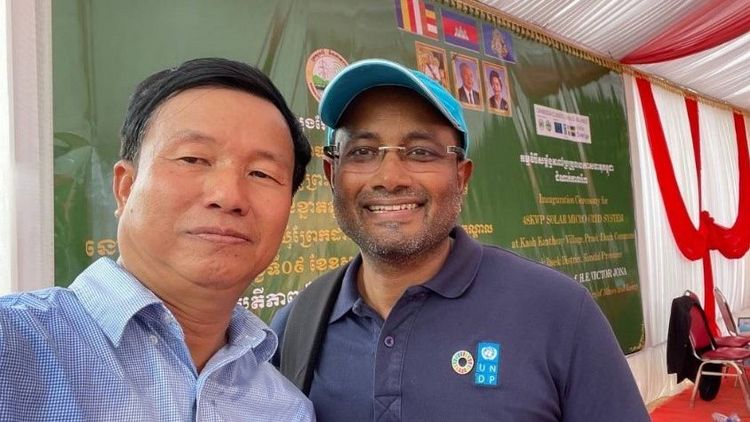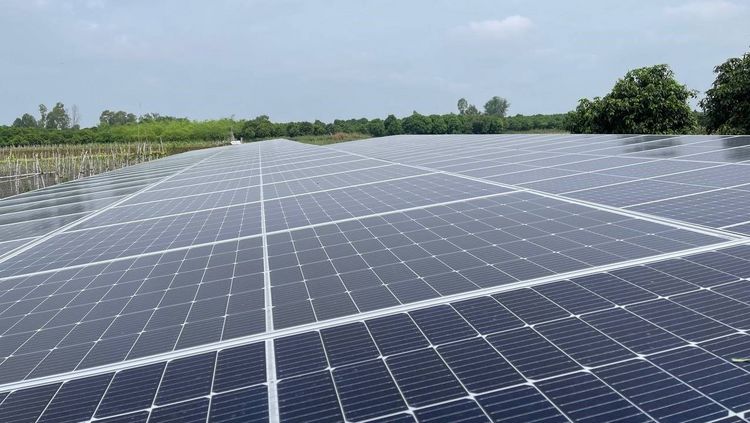From the past two decades, Cambodia rapidly expanded electrification of villages, and achieved 98.3% of villages covered with national grid by the end of 2022 from 6.6 % in the year 2000. Cambodia is expected to graduate from least developed country (LDC) status as early as 2027. The national Power Development Plan of Cambodia forecasts more than 2.5 times power demand from current 4,014 MW i.e., to 10,794 MW by the year 2040.
Cambodia made announcements in recent years that there will be no new hydro projects on the mainstream Mekong River and no new coal power plants except those were signed before 2019. Certainly, reduced dependence of Cambodia on coal will lead to economic gains and improve energy security. It is also going to contribute towards its climate goals, which is a twin benefit.
Cambodia is blessed with a high potential of solar energy that is largely untapped to date. Of the estimated 2.6 GW of solar potential, on-grid utility scale solar capacity is at 472 MW by 2022. Auctions mechanism combined with concessional financing has helped to bring down the cost of solar energy to a competitive tariff of 2.57 US cents/kWh, as it was demonstrated in the case of 40 MW National Solar Park. This excludes the cost of land as it will be provided by state utility, Électricité du Cambodge (EDC). The installed rooftop solar capacity to date is around 60 MW out of 870 MW of rooftop potential “Assessment of Potential for Behind-The-Meter Solar Energy in Cambodia” final report by Investing in Infrastructure (3i); 26 October 2020). Similarly, Cambodia has wind power potential of at least 1,580 MW with 80 MW ready for deployment (“Variable Renewable Energy Assessment & Integration Strategy for Cambodia”, report by Investing in Infrastructure (3i); October 2021). It is already testing the battery energy storage system combined with solar park (https://www.adb.org/news/adb-edc-sign-mandate-2-gw-solar-and-battery-storage-power-program-cambodia). Under these circumstances, how could Cambodia satisfy the future load growth adhering to the principles of reliable and affordable electricity?
Cambodia expanded its national electricity grid access across the country from 6.6% in the year 2000 to 98.3% by the end of 2022, showcasing that it can achieve a transition that is equitable and sustainable. Further aiming to connect the remaining off-grid villages with feasible technology solutions including solar mini-grids on the principle of inclusion and leave no one behind. It once again needs to demonstrate a transition in its energy generation mix with rapid deployment of low-carbon technology choices such as renewable energy, moving away from import of electricity from other countries.
The path to low carbon transition of energy sector means exploiting the full potential of solar energy including rooftop solar combined with a gradual increase of wind energy on the grid. Cambodia is already testing the battery energy storage system combined with solar park. Increased deployment of such technologies will stabilise the grid as the share of variable renewable energy is bound to increase. Further, strengthen the grid management and control with better forecast technologies, wider deployment of central control system-SCADA, and increase the number of sub-stations. These interventions will improve the resilience of energy system in this transition.
Energy efficiency plays a key role in this transition by bringing efficiency gains in different sectors of the economy and reducing energy sector vulnerability. National energy efficiency policy identified that Cambodia has the potential to save 12.50 TWh (1.07 Mtoe) of energy by 2030 through energy efficiency measures that need an investment of US$ 3.0 billion. Commercial and residential buildings have the highest potential to attract investments. Energy efficiency has a huge job creation potential ranging from 10 to 15 jobs for every million dollars invested. Further, it was estimated that more than 500,000 additional jobs could be created until 2030 if Cambodia would follow the Green Industry scenario.
Transport sector is gearing for a rapid deployment of electric vehicles, to about 70 % in two-wheeler and 40 % in cars and urban buses segments by 2050. Further reduced import tax and duties on electric vehicles, which is now 50% lower than on vehicles with internal combustion engine. Cambodia is encouraging investments in EV assembling plants. This move has the potential to create more green jobs and investments and help position Cambodia in the emerging global and regional supply chains for EVs.
Although it appears challenging to achieve this transition towards promoting less energy imports and maximising the use of indigenous resources midst of rapid economic growth, but achievable. This transition is considered equitable and resilient with socio-economic gains. Cambodia is not alone in this journey, but remain as an example to other countries in a transition that is inclusive and just for all.
Further information on the salient features of power development in Cambodia: https://www.eac.gov.kh/uploads/salient_feature/english/salient_feature_2022_en.pdf
Text by Heang Bora and Dr. Butchaiah Gadde



